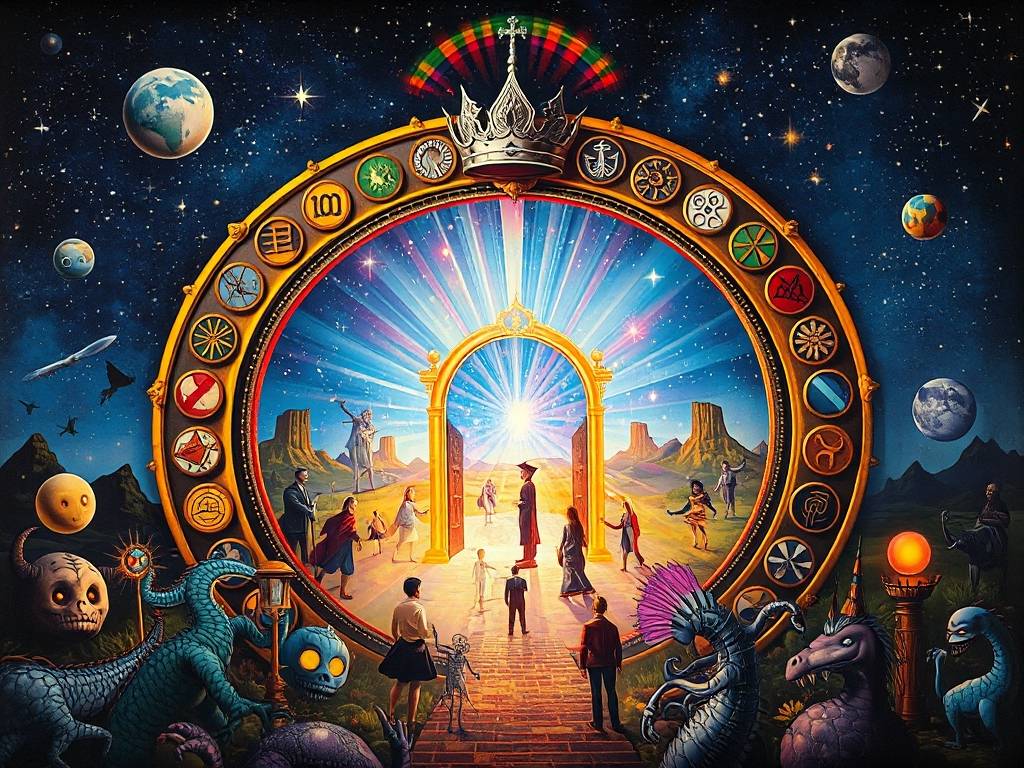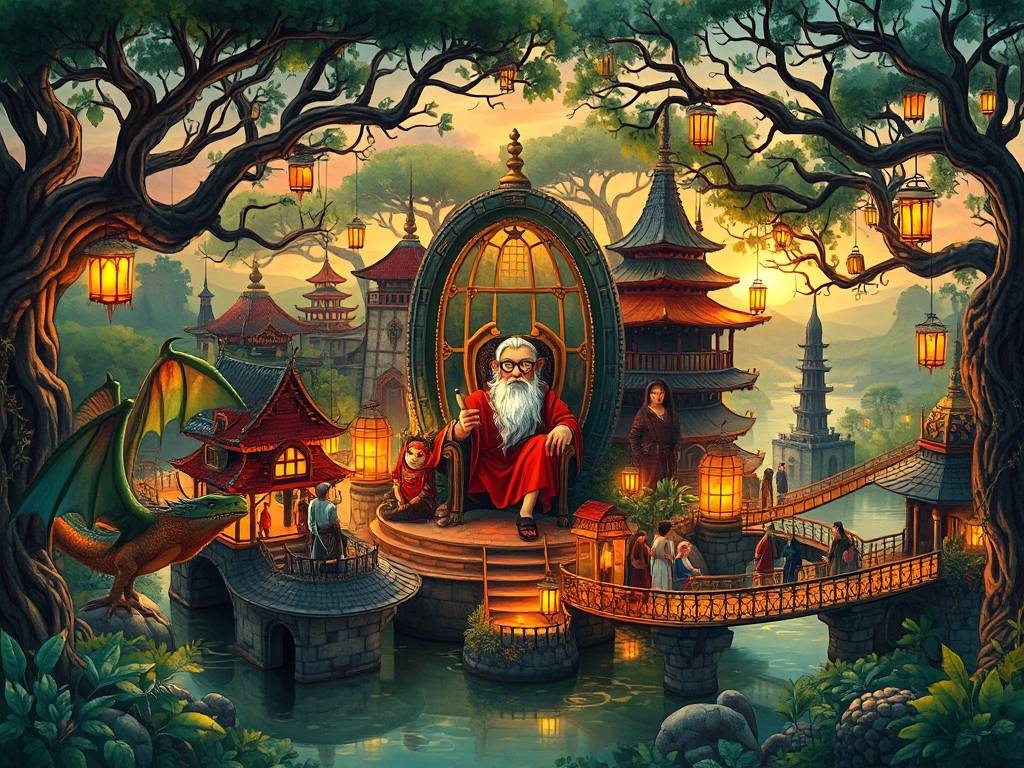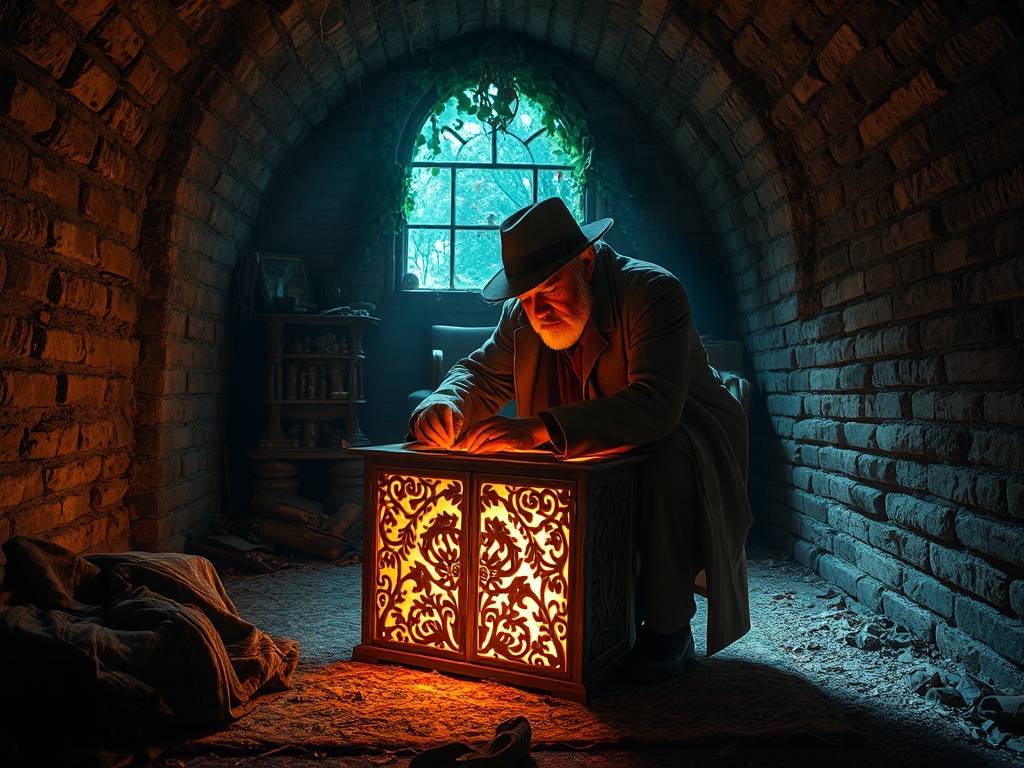Mysterious Echoes of China: Those Folk Tales Passed Down by Word of Mouth
In the 5,000-year history of China, beyond the dynastic changes and heroic legends recorded in official histories, there are countless folk tales and strange stories scattered among the people. Like twinkling stars in the night sky, they have not been included in the thick historical books, but have been passed down from generation to generation through word of mouth. These tales carry people’s curiosity about the unknown world, their yearning for a better life, and also hold the unique cultural codes of different regions. Some are eerie and bizarre, some are warm and touching, and others are full of warnings—like mysterious treasure boxes waiting for us to open and explore the folk wisdom and ancient legends hidden within.
I. Mysterious Legends in the Mountains: Xiangxi Corpse-Chasing and the Millennium-Old Tree in Qinling
When it comes to folk tales, the legend of Xiangxi corpse-chasing is definitely a topic that cannot be avoided. In the high mountains and deep valleys of Xiangxi, the elderly can still vividly tell stories about corpse-chasers. It is said that during the Republic of China era, transportation in Xiangxi was underdeveloped. When local people died far from home, their families, unwilling to let their loved ones be buried in a foreign land, would hire corpse-chasers to bring the bodies back to their hometowns for burial.
Corpse-chasers usually wore long indigo robes, bamboo hats, and a thin veil covering their faces. In their hands, they held a peach wood staff wrapped with yellow talismans. Every night, the sound of "rustling" footsteps could be heard on the mountain paths. Accompanied by the low incantations of the corpse-chaser, a line of corpses, draped in black shrouds, walked slowly with their arms stretched straight, following the corpse-chaser’s steps. What was even more bizarre was that the corpses seemed to sense the road conditions—they would automatically lift their feet when encountering ditches and turn when reaching bends.
Some say that corpse-chasers used special herbs and talismans unique to Xiangxi to keep the corpses stiff yet movable; others claim it was just an illusion created by the corpse-chaser and their assistants—the corpses were actually cleverly placed on two bamboo poles and carried by people. Although transportation has now become convenient and the custom of corpse-chasing has long disappeared, this legend still lingers in the mountains of Xiangxi, becoming the most mysterious part of the local folk culture.
Deep in the Qinling Mountains, there is also a strange story about a millennium-old tree. This ancient tree grows beside a small village at the foot of Taibai Mountain, the main peak of Qinling. Its trunk is so thick that it takes five or six people holding hands to encircle it, and its lush branches and leaves spread like an umbrella, covering the sky and the sun. The villagers regard this tree as a "sacred tree." On the 1st and 15th of each lunar month, they bring incense and fruits to worship it, praying for the safety of their families and a good harvest.
What is even more amazing is that this ancient tree seems to have "spirituality." It is said that decades ago, a naughty child in the village climbed the tree to play and accidentally fell from a high place. Just when everyone thought the child would definitely die, he fell to the ground unharmed—while a thick branch of the ancient tree suddenly broke for no reason. Another time, the village suffered a severe drought: the land cracked, and the crops withered. The villagers were anxious and rushed to the ancient tree to pray for rain. Unexpectedly, three days after the prayer, dark clouds gathered in the sky, and a heavy downpour fell, relieving the drought. The villagers all said it was the sacred tree showing its power to protect the village. Later, the local forestry department took measures to protect the ancient tree, prohibiting villagers from climbing or cutting it down. To this day, the tree remains lush and green, guarding the peace of the village, and the legends about it continue to be told among the villagers.
II. Eerie Tales in the Water Towns: Jiangnan Water Ghosts and the Ancient Mansion in Gusu
The water towns of Jiangnan, with their crisscrossing rivers and swaying Wu peng boats, are like a gentle and beautiful painting. However, beneath this soft scenery, there are also many eerie folk tales—among which the legend of "Jiangnan water ghosts" is the most well-known. In many water towns of Jiangnan, the elderly always warn children not to play by the river, especially in the evening and at night, because "water ghosts" live in the river.
It is said that water ghosts are the spirits of people who drowned. Unable to be reincarnated, they can only wait in the water to find a replacement. Whenever someone approaches the river, the water ghost will use invisible hands to pull the person into the water, making them the new replacement so that the ghost itself can be reincarnated.
In Zhouzhuang, Suzhou, there was once such a story: during the Republic of China, there was a young boatman in the town who rowed a Wu peng boat to carry passengers on the river every evening. One day, he met a woman in a white dress by the river. The woman said she wanted to go to her mother’s home on the other side of the river, so the boatman let her get on the boat. When the boat reached the middle of the river, the boatman suddenly felt the boat become unusually heavy. He turned around and saw that water was dripping from the woman’s feet, and her body was becoming transparent.
The boatman was so scared that his soul almost left his body. He quickly picked up the oar and hit the water. The woman let out a shrill scream and disappeared into the water in an instant. After that, the boatman never dared to carry passengers in the evening again. The legend of "Jiangnan water ghosts" spread even wider in Zhouzhuang, becoming an eerie memory that lingers in the hearts of people in the water towns.
Besides the water ghost legend, the strange stories about ancient mansions in Gusu (Suzhou) are also fascinating. In the old town of Suzhou, there is an ancient mansion built in the Qing Dynasty. Although it is not large in area, it is called a "haunted house" by the locals because of the frequent strange incidents that occur there. It is said that this mansion was originally the residence of a wealthy merchant. Later, the merchant’s family suddenly moved away and never returned. Since then, the mansion has been uninhabited and gradually fell into disrepair.
Some bold vagrants once tried to stay in the mansion overnight, but they heard the sound of a woman crying and footsteps in the mansion late at night, so they fled in a hurry. Some villagers also said that on the night of the full moon, they could see faint candlelight coming from the windows of the mansion, and vaguely saw a woman in ancient costume dressing up by the window.
What was even more bizarre was that in the 1990s, a developer wanted to buy the mansion for renovation. After the construction team entered the mansion, accidents happened one after another: when a worker was demolishing a wall, a rotten coffin suddenly fell out of the wall, and inside the coffin, there were even some well-preserved Qing Dynasty jewelry; another worker suddenly felt dizzy and nauseous while working, and even fainted. Helpless, the developer had to abandon the renovation plan. To this day, the mansion is still abandoned in the deep alley of Suzhou’s old town. The eerie legends about it make passers-by can’t help but quicken their pace, daring not to stay for long.
III. Fantasy Stories on the Plateau: Tibetan Lake Monsters and Xinjiang Stone Men
On the vast Qinghai-Tibet Plateau, under the blue sky and white clouds, lakes are inlaid on the grasslands like gemstones. Here, there are not only magnificent natural scenery but also many folk tales full of fantasy—among which the legend of "Tibetan lake monsters" is one of the most famous.
In Nam Co Lake in Tibet, the local Tibetan people have such a saying: at the bottom of the lake lives a huge lake monster. It looks like a fish but is dozens of times larger than an ordinary fish, covered with hard scales, and its eyes are as bright as lanterns. It is said that the lake monster rarely appears; it only shows itself occasionally when the weather changes suddenly and strong winds rage on the lake surface.
In the 1950s, a scientific expedition team came to Nam Co Lake for research. While camping by the lake, the team members suddenly heard a loud noise from the lake. Looking up, they saw huge waves several meters high surging in the water, and a huge dark shadow jumped out of the lake before sinking back into the water in an instant. The team members were so frightened that they quickly took out their cameras to take photos, but only captured a blurry dark shadow. Later, the expedition team conducted in-depth surveys of Nam Co Lake and discovered many unknown creatures at the bottom, but never found conclusive evidence of the lake monster’s existence. Nevertheless, the legend of the "Tibetan lake monster" still spreads on the Qinghai-Tibet Plateau, becoming the most fantasy-filled part of the local folk culture.
On the grasslands of Xinjiang, there stand many mysterious stone men. Some stand, some sit, with different shapes—some hold weapons, and some wear smiles. These stone men have also given rise to countless folk legends. On the grasslands of Altay Prefecture, Xinjiang, the local Kazakh herdsmen say that these stone men are the incarnations of ancient grassland heroes. They were brave in battle during their lifetime, guarding the peace of the grasslands. After their death, people carved them into stone men to continue guarding the grasslands.
Another legend claims that these stone men possess magical powers. When herdsmen worship in front of the stone men, they can receive the protection of the heroes—the cattle and sheep will grow fatter, and the grasslands will become more fertile. A herdsman once said that a group of wolves once broke into the grassland and attacked the herdsmen’s cattle and sheep. Helpless, the herdsmen went to the stone men to pray for help. Unexpectedly, that night, a strong wind blew on the grassland, making the wolves lose their way in the wind and finally leave the grassland. Although these legends lack scientific basis, the stone men remain one of the most mysterious landscapes on the Xinjiang grasslands, attracting countless tourists to come and explore their secrets.
IV. Warm Stories in the Cities: The "Cat Immortal" in Beijing Hutongs and the Gratitude Story in Shanghai Lanes
Not all folk tales are eerie and bizarre. In the busy city streets, there are also many warm stories passed down among the people. In the old hutongs of Beijing, there is a legend about the "cat immortal." Deep in a hutong, there is an old quadrangle courtyard where an elderly grandmother lives alone. The grandmother is kind-hearted and often feeds the stray cats in the hutong.
One winter, the weather was extremely cold. The grandmother caught a bad cold and had a fever, lying in bed unable to move. With no relatives around to take care of her, her situation was very critical. At that moment, an orange cat that the grandmother usually fed suddenly disappeared. A few hours later, the orange cat came back with a neighbor to the quadrangle. After discovering the grandmother’s illness, the neighbor quickly sent her to the hospital, and the grandmother recovered.
Since then, the grandmother loved the orange cat even more. People in the hutong all said that the orange cat was a "cat immortal" who had come down to repay the grandmother’s kindness. Another time, a fire broke out in the hutong, and the flames spread quickly, threatening to reach the grandmother’s quadrangle. The orange cat suddenly rushed into the house and kept meowing at the grandmother’s door. The grandmother was woken up and escaped from the quadrangle in time, avoiding danger. The legend of the "Beijing Hutong Cat Immortal" fills the cold old hutongs with warmth and makes people feel the deep bond between humans and animals.
In the old lanes of Shanghai, there is also a folk story about "gratitude." In the 1930s, a poor young man lived in a Shanghai lane. He made a living by pulling a rickshaw, and his life was very hard. However, he still maintained a kind nature. One day, the young man found an injured puppy at the entrance of the lane. The puppy’s leg was broken, and it was on the verge of death. Unwilling to let the puppy die, the young man took it home, used his meager savings to treat its wounds, and took good care of it.
After the puppy recovered, it stayed by the young man’s side, becoming his companion. Once, when the young man was pulling a rickshaw through a remote alley, he encountered several robbers. The robbers took the money from the young man and even tried to harm him. At that moment, the puppy suddenly rushed forward, barking fiercely at the robbers and biting the leg of one robber. Frightened, the robbers fled quickly, and the young man’s life and property were saved.
Later, the young man’s life gradually improved. He and the puppy lived together, depending on each other. People in the lane all praised the puppy for being intelligent and said it had come to repay the young man’s kindness. This warm legend has been passed down in the old lanes of Shanghai for a long time, becoming the warmest memory of the city’s streets.
Folk tales and strange stories are an important part of Chinese culture. Born from the lives of the people, they reflect people’s joys and sorrows and carry their beautiful wishes. Although these stories may lack conclusive evidence and are full of exaggeration and imagination, they record the cultural characteristics of different regions and convey folk wisdom and warmth in a unique way. Whether they are mysterious legends in the mountains, eerie tales in water towns, fantasy stories on the plateau, or warm anecdotes in cities, they are like vivid symbols, outlining the colorful features of China.
Today, with the development of the times, many folk tales are gradually being forgotten. However, the cultural value and spiritual connotation they contain are worth cherishing and inheriting. For these stories are not only memories of the past but also a link connecting history and the future. In the process of exploring these folk tales, we can better understand the profound heritage of Chinese culture and feel the unique charm of folk life.








发表评论